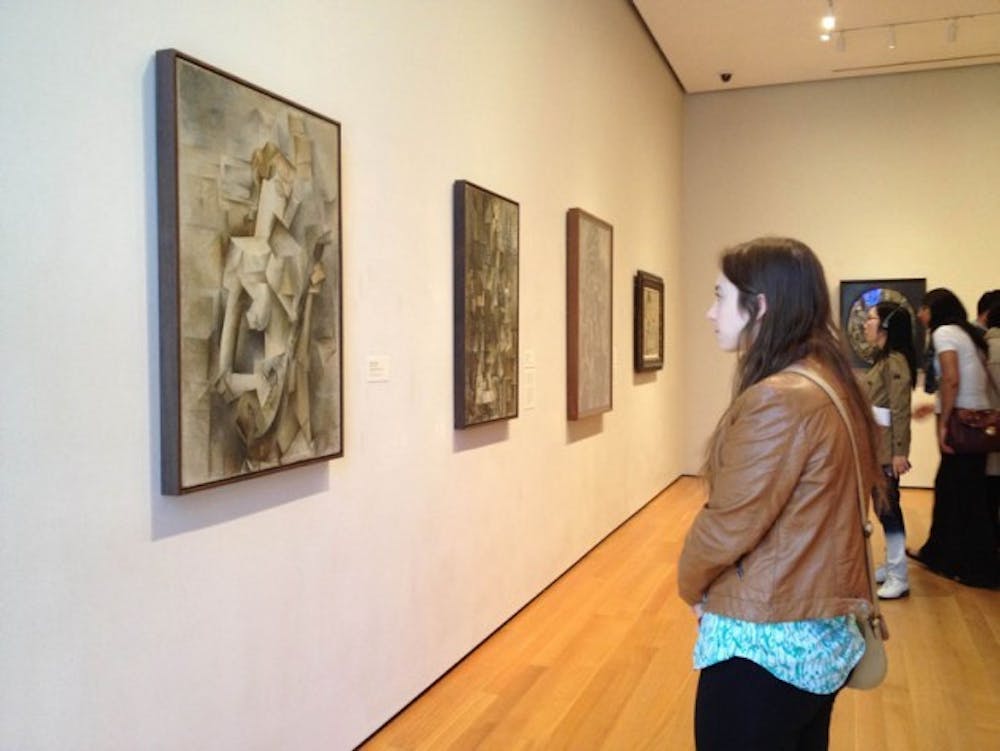A six-hour bus ride was all that separated 52 UB students from the artwork they've examined in art history courses to the museums in New York City that house them.
“Many students have the impression that seeing art in a book or on a screen is enough. It’s not,” Domenic Licata, an instructional support technician and instructor with the Department of Art, said in an email. “We created this opportunity to make it easier for students to get out and see the world’s greatest art collections for themselves.”
The daylong trip began at 11:30 p.m. on Thursday when a bus with 52 students – 46 art majors and six non-art majors – and four staff members departed for New York City. Domenic Licata, Natalie Fleming and Daniel Calleri, the UB staff who organized the trip, believe it is crucial for UB art students to be exposed to what the city has to offer, which is some of the best art collections and galleries in the world.
“There is nothing like standing in front of a work of art that you have studied,” said Daniel Calleri, an instructional support technician for UB’s photography department.
Calleri said it’s important for students to get out into the “real world” where the scale, texture and material of the paintings and objects become important.
Many students on the trip saw art they were familiar with. AnnMarie Agnes, a senior general studio major, remembers learning about Claude Monet’s “Water Lilies” during an art history course. The painting of the water lilies became her favorite piece from the trip.
Photographs in textbooks never compare to the actual piece of art, according to Agnes.
“It was amazing how immense the work is, and since you're always shown it in a smaller size, it felt as if I was seeing the piece zoomed in, but that was what it was always like,” Agnes said. “And that kind of blew my mind.”
Agnes is able to appreciate the pieces more after having taken art history courses.
“I always thought that modern art was just weird and that anyone could make something like Rothko or Pollock,” Agnes said. “And that type of thinking devalued their importance to art as a whole, which I now realize.”
The trip organizers suggested museums to visit, but encouraged students to make their own decisions about what they thought was best to experience.
Fleming, the resource curator for the visual studies department, thought it was essential that students have freedom on the trip.
“We believe it’s important that the students have the opportunity to make of the trip what they wish,” Fleming said. “There are so many art institutions in New York City that it would be impossible to visit all of them, and not every student is interested in visiting the same works of art.”
Students appreciated the less structured atmosphere.
“I really liked that the trip was self guided and let us venture out on our own,” Agnes said. “I’ve never had the chance to go off on my own in a large city like New York, and I found out that it came really naturally to me. After navigating through New York on my own I feel like I could easily live in that type of setting, which is a change from growing up in the country.”
Van Tran Nguyen, a senior biology and fine arts double major, also appreciated the way the ARTbus trip facilitated a space in which she could explore the city on her own.
“I think students should be urged to get lost – don’t really have a plan and devote some time to being lost in the city to find something they aren’t looking for,” Nguyen said.
The trip was open to all majors; non-majors were required to pay $47, while art majors only had to pay $25 to board the ARTbus.
Nguyen believes non-art students can have an equally valuable experience under certain conditions.
“They cannot disregard the art instantaneously if they dislike it ... it probably means they do not understand it,” Nguyen said. “And disliking something you don’t know is stupidity.”
She believes that future trips should remain open to non-majors with priority given to art majors.
“Art majors are both makers and observers,” Licata said. “Non-art majors, as observers, can be equally inspired by viewing great work first hand, as much as they would be by hearing a live performance by the [Buffalo Philharmonic Orchestra], or by attending the theatre. Great art benefits us all.”
Many of these classic pieces have been well preserved and have become recognizable pop culture icons, which is one of the reasons Fleming believes non-majors could still appreciate the artwork on display.
Agnes thinks it’s important that these works continue to be displayed for the public in galleries and museums, like the Museum of Modern Art and the Whitney Museum of American Art which are both located in New York City.
“Art is a big part of our culture,” Agnes said. “It critiques and comments on our society and it's important to keep art around to keep creating a visual commentary of the world.”
Calleri partially credited the success of the trip to Steve Kurtz, the chair of the art department, for helping to subsidized the cost of the trip.
Licata, Calleri and Fleming hope to organize more trips and are considering ones to Chicago or Washington D.C. in the future, as long as they have the funds. Licata hopes that future trips will be run and sponsored by students rather than the department, which would give students more of an input in choosing trip locations.
Jenna Bower was one of the 52 students on the ARTbus
email: arts@ubspectrum.com





